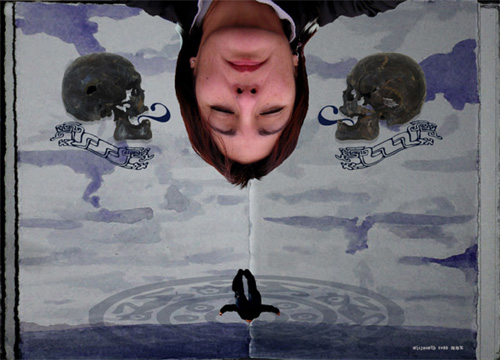
Female artists web projects and networks

Two concrete cases: eyeseverywhere//ojosportodoslados and MMX::mexican female artists in 2010.
Introduction
The web, internet, is a huge space where converge information and communication, that is interactive and open to cooperation among peers, whom connect thanks to the expressed interests and personal relations given inside this multiple virtual communicating vessels that conform the net. The relations formed this way permit to widen the interaction horizons in a way never believed before. The geographic or physical isolation is abolished resulting in a new global social fabric that becomes tighter every day, though it has also a liquid quality. This means that the will offers permanence and navigation mobility widens or reduces the action fields.
Peers meeting, (individuals with similar interests converging in a specific spot in this digital ocean), usually results in an immediate and diverse exchange of information. Knowledge, image, video, sound, contacts, ideas and any kind of information data come and go through the web and its exchange becomes barter. The web contents big majority is under copyleft and we can say democracy acquires a glimpse of reality here.
To create collaborative art projects in this environment is a real alternative of proven efficiency that amplifies the possibilities and the creative and geographic horizons. It allows to create global artistic and social networks that transcend –and generally this is their aim- digital space, art market and, specially, art institutionalism. They are creative alternatives to Mainstream and set their own rules, as flexible as efficient, and constantly propose new approaches to the creative process, artworks and artists and, definitively, to Art itself.
Besides all, they allow the possible concretion of the projects in the real world and, a very important issue, to enrich the social and personal relationships. All this is especially important for female artists, who must break through a territory controlled by the androcratic mainstream art market and that most of the times they could remain invisible even in their own surroundings.
These are stories coming from an individual artist meeting her peers in the web to create their own territories where to intertwine their artworks, their subjectivities, their eyes.
Eyeseverywhere//ojosportodoslados
As an artist and cultural manager, living in a Mexican city where cultural life had its limits defined, and with an urging need to expand my professional career, l create eyeseverywhere//ojospsortodoslados at the end of 2006.
My objectives part from the need to offer a visual discourse and an aesthetic proposal that within a periodicity allowed a constant flux that could go beyond the mere local. The web offers this possibility as long as attention and persistence exists. The project was just ideal to share my photographic self and to start a dialogue with other artists and, as a main endeavor, establish human relationships with women making art in other latitudes of the world. To make this I contacted with two artists friends and proposed the project. One, Ayanna Jolivet McCloud, lives in the USA and she found me in the net searching for Ritual Art. The other, Lau Mun Leng, is from Malaysia and lives in the UK. We met during an art residency in Austria. This was the beginning of a fabric we all have been knitting.

S/T, Montevideo, Uruguay- Bruselas. eyeseverywhere//ojosportodoslados Sandra Petrovich, 2006
So, in January 2007, photographs made by artists of several nationalities living in different parts of the world start being published every Saturday in a blog. From places like Dubai, Montevideo, Vienna, Puebla, Kuala Lumpur, Berlin, Stavanger, Buenos Aires, Doha, Bilbao, New York, Vilagarcía, Seoul, Brighton, Barcelona, Gijón, Santiago de Chile and many other cityes and towns in the world –and l will mention here each and every one of the collaborators past and present- Ayanna Jolivet, Teresa Puig, Eva Brunner-Szabo, who no longer publish but are linked to the project, and Lau Mun Leng, Marta Rial (Marthazul) , Mercedes Fidanza , Sandra Petrovich , Inge Hoonte, Inka Resch , Carolina de la Peña, Àgnes Bttfn , Nicole Rademacher , Aimee Lee and Elizabeth Ross, we all share our visual reflection on issues that change every month, suggested in a roll by each one of us, and coming from out shifting identities .
Our photographic work is rarely manipulated. Instead, it portraits a direct reality, being it urban or rural, intimate or social, and the themes explored range from the sociologic spheres like in Crisis, Excess, In/dependence, Resistance, Games of Power, to the joyfully aesthetical as exploring the orange color, the cracks or blindness.

Orange. Malaysia / Brighton, Inglaterra, eyeseverywhere//ojosportodoslados. Lau Mun Leng, 2007
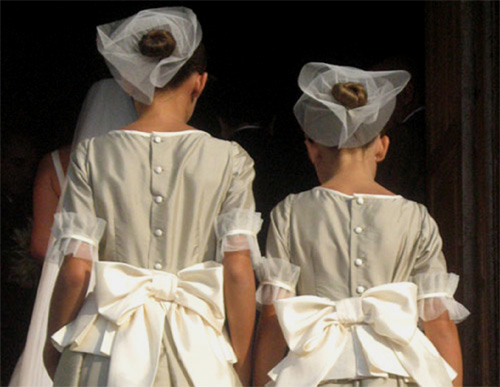
Ellas (Las niñas) Vilagarcía de Arousa,Galicia. eyeseverywhere//ojosportodoslados). Marta Rial, 2009.
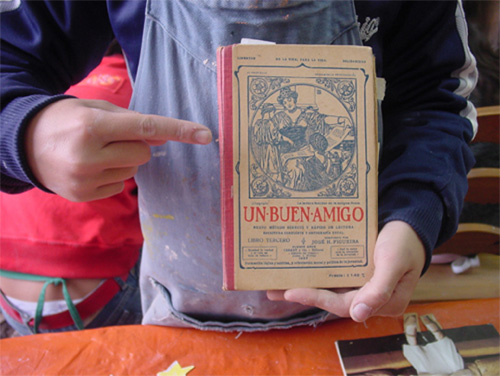
Amistad (Amigo). Buenos Aires, Argentina. eyeseverywhere//ojosportodoslados, Mercedes Fidanza 2009.
We want to turn visible elements of daily life with an existential aesthetic at the same time that eyeseverywhere//ojosportodoslados turn us visible as female artists and as persons that share our personal discourse around a virtual and creative bonfire that involves time, space, attention, professionalism, solidarity, to link it into the collectivity and to produce a place we inhabit aesthetic, conceptual and intersubjetively between the private and the public.
The initial personal drive has become the drive of all, who during the days of the week keep our eyes open to catch the momentum that we’ll take into the circle the next Friday. We have met in this Saturday Home for four years now. And I say home as dwelling and as central fire. And I say circle because that is what we are now; each Saturday we hold a visual Witches’ Sabbath all our own, cast into the net universe. In these 4 years we have known each other in an intimate way because we do it through our eyes and dreams. And just a few know some others in the physical world, but yet we have consolidated our collective being, every week more solid, and now we have brought off a material achievement of these 4 years of constant work, turning them into a video that is screened in the –real- cities each of us live in. In January 2011 we will be 5 years being on line, networked, and having our eyes everywhere
MMX::mexican female artists in 2010
2010 has been the Latin America Independence from the Spanish colonization Bicentennial celebration. Mexico also celebrates 100 years of the Revolution burst. México, therefore, celebrates –institutional, formal and mainly politically-, two wars. It does eagerly to build social cohesion around a fragile national project framed by inner war, as the dividing aftermath from the electoral fraud that radicalized the sociopolitical differences, narcowars, global crisis and the lack of social sensibility from who encroach on power. There are crisis times and the actual government has reserved a big amount of public money to praise a history of resistance to power. Its desperate and ambiguous speech of a national identity quest has all public entities around the Bicentennial projects and calls. The quantity of budgets and the impossibility of working in any other kind of subjects, made many artists to apply with proposals of their national history versions in order to obtain funding to keep on working or just subsist. The Bicentennial carrot produced some interesting projects, as Antonio Gritón Rage and Desire, which involved an appropriation of the public space by visual artists and performers, or before him, the Mexico City Bicentennial Engraving, organized by Centro Cultural Estación Indianilla , a monumental artwork coordinated by a 5célula member, Lenin Fajardo, that became the biggest print ever, with more than a kilometer long.
In the other hand, there are those who decide not to celebrate violence as a mean to reach peace and liberty or solve conflicts. Specifically, Mónica Meyer and Víctor Lerma project “I don’t celebrate or commemorate wars”, which started as a Cause in Facebook and has done several collective actions using this social network and their own interactive website . As a feminist artists fighting for Life it is here where l can place MMX::mexican female artists in 2010 and, as l wrote in the homepage of the blog: “ we, starting this project, are not into any official program and, therefore, out of any of their budgets. We are from the ones who won’t celebrate or commemorate any type of war as we know that these occupying our country’s political imaginary haven’t given us even an identity but just a stereotype”.
MMX::mexican female artists in 2010 is eyeseverywhere//ojosportodoslados sister project. Photos and video are published in a wordpress blog two times per month, and involves a group of Mexican artists coming from different generations, experiences and geographic situations exploring the identity concept as Mexican women practicing a critical thought on their historic and vital times during this year.
MMX::artistas mexicanas en el 2010 is formed by several artists living in the country: Amérika Arzate, Carolina de la Peña, Claudia Piccone, Diana Maldonado, Ireri Castro , Paulina Álvarez, Rosa Borrás and Lucero González , director of the Museo de Mujeres|Artistas Mexicanas(Museum of Women| Mexican Arists). But also there are some that have emmigrated by a variety of reasons: Chispillatronik (Claudia Castelán) to Barcelona, Yolanda Petrocelli to Connecticut and me, a nomad with no address, and we all live our mexicanity from different cultural and subjective innerlands.
An important fact here is that all began in Facebook. There we made the first contacts and we who had been lost met again. One more time, this social network is definitive as encounters generator and trigger of projects, when it allows a virtual space where individuals with interests alike looking for feedback can find each other and be and create together. So, even if we don’t know each other in person, the shared information enable us to perceive potentials that, within the everyday work, prove the initial perception.
Every one of us has a particular discourse inside this Project. As, for example, Diana Maldonado , artist working as journalist photographer, who brings up a diversity of situations Mexican women go through every day in sports, work, service, home, public space. Women performing common tasks that civilization wouldn’t work without, seen through Diana’s sharp eye.
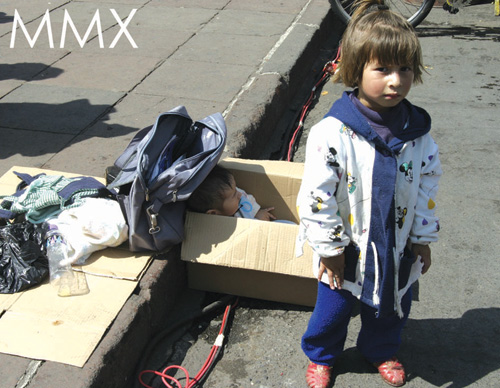
Mujeres Mexicanas I. MMX::artistas mexicanas en el 2010. Diana Maldonado 2010.
Another artist working with daily images (de)forming Mexican everyday life is Carolina de la Peña . She talks of herself putting on our virtual table images with a sociological strength showing up the urban flow of the largest city in the world where the emotional and cultural charge manifest through simple elements as a lotto bill (“2”) or a crowded metro wagon full of women showing infinite weariness or men’s clouded eyes by harassment, (Vagón para mujeres/women’s train y Acoso).
Claudia Piccone , as many of us, works in series as they allow to develop an aesthetic and conceptual discourse. One of them Frida la Sufrida (Frida the Sufferer), makes a humorous critic to the excessive commercial manage of Kahlo’s image, as her artistic and political position is never even touched. Claudia doesn’t stop in this but the critic points to the false stereotype of Mexican (and not only) women as submissive, quiet and, yes, a sufferer, that the deciduous androcratic power insist to maintain (see the whole series in post from February 28 to April 11. Frida se Suicida).
In some of the artists more personal narrative, as Ireri Castro (fig.6), Rosa Borrás, Paulina Álvarez, Chispillatronik or Lucero González, image (or video) slowly and patiently embroiders space/time with stitches that join the universal “up” with the inner human “down” (see Ireri Castro Mutaciones ), past with present and its reflections (see Lucero González My daughter myself or Naked time digitalized analogical images),or the process involved in undressing from old useess vestments when confronting our own identity with a different culture, as Chispillatronik in What l left behind, (Lo que dejé).
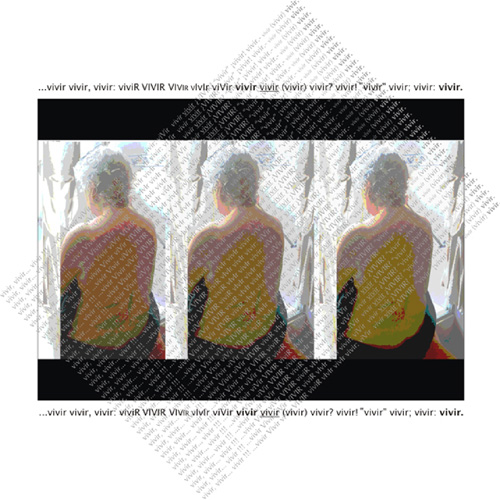 Vivir. MMX::artistas mexicanas en el 2010. Ireri Castro 2010
Vivir. MMX::artistas mexicanas en el 2010. Ireri Castro 2010
Paulina Álvarez and Rosa Borrás, both living in Puebla, give a quite different treatment to their artwork. The first one, very young, offers to us a microscopic vision exalting color and emphasizing details usually unseen, what gives her photos a pictorial character that even becomes abstract (example II). Rosa Borrás , in the other hand, plays with different media as drawing (Pair), el video, el escaneo ("Blanca y Kena. 1960-2010"), photography. With this tools she tries to assemble a puzzle where the Little pieces are small parts of an era and a personal becoming that, with natural force, belongs to several generations of Mexican women that have broken, or tried to break, that poisonous stereotype that telenovelas (soap operas) bring to (almost) every Mexican home.
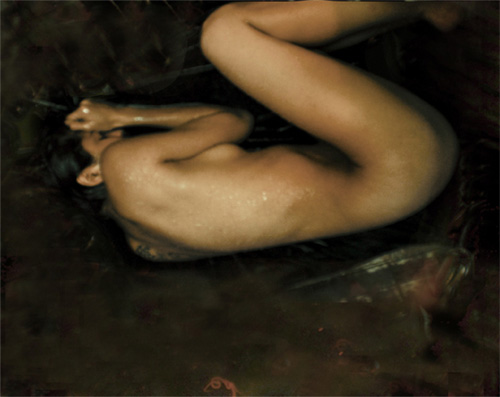
Matriz. MMX::artistas mexicanas en el 2010. Amérika Arzate 2010.
Amérika Arzate (fig. 7), is the youngest of us all and the one who is more immersed in digital arts and culture. Even so, for MMX she has preferred to show artwork in a wider range that speaks about a vector of inner search firmly rooted in her technological knowledge. You can sense feminist findings and a slow detachment of growing pain, that enhances her artwork with a surplus, as it let us peep into the inner struggles of a whole young women generation that finds itself lost between what women before them have achieved and the lack of own conceptual reaffirmation.
In the other generational range we have Yolanda Petrocelli, who explores her mestiza identity as her artwork conductive line through digital creation and manipulation, reaching quality and forcefulness. Her self-portraits are excuses to underline her mixed blood and highlight the Indian part of it. From the United States she sails between those two conceptual seas which are her indigenous background and her technological management, to establish the flexible and clear identity of a contemporary Mexican woman.
My personal proposal for MMM as an artist comes from my nomadic quality, that turns me into an immigrant, and has two lines: a series based in an dreamland narrative (the dreams of the immigrant), where l have digitalized self portraits worked as collages to speak about the inner drive to endless mobility, using also prehispanic iconography as subtle identity elements. This series is intercalated with pieces of a major project [And, where are the women? (I am an outsider)], a research on women and migration where l use video to give voice to other Mexican women that have left the country pursuing their own dreams and which l have crossed with in my own path. (as an example Lourdes: clear and direct).
So we all have been sewing, cooking, building, shaping a discourse that dissects our national identity and shows to ourselves the guts and secrets of what it means to be a woman, to be a woman with a defined culture as is the Mexican, to be a woman in this crisis year of this twenty one century. To be it at home or in lands that are not so alien after all.
MMX has given us feedback in the press because they have found its collectivity and pertinence interesting. Now, we are planning to make a show of the whole work in different venues in México and, why not, in the USA and Spain, next 2011.
It is useless now to underline that we all draw on technological tools to make our artwork and to project it into the public that receive it, as it is no other way to do it if we want to have a presence, an existence. And is this existence, promoted by the data pure energy travelling through and invisible web, which allow us to inaugurate constantly new action fields, new territories of our own, not just rooms anymore, where to become as women artists with concrete, visible, vigorous, hearty art proposals. Where the process and its significant and the interactivity between the groups and the public give shape to a complete creative and cool body of artwork, as Mac Luhan would state.
As a conclusion, in both cases, eyeseverywhere//ojospsortodoslados and MMX::mexican female artists in 2010, internet make us together and make us visible, allow us to transcend the daily constricted room and to have a mobility outwards, to the immense public online, and inwards to the center of our own creation (me/them/us) as artists, as women, as the social designers we are.
Elizabeth Ross, A Coruña, May 2010
Notas:
Eyes begun three years ago with a picture published every Saturday, but now it’s something more. It’s a discreet but constant project, made out of silent and permanent heartbeats. It means being watchful each week, with wide open eyes, to everything that happens in front of us so we can capture or remember it according to each month’s theme. It’s the ritual of writing Elizabeth each Friday telling her why I chose this image. Artistic views from different women from disparate locations, who come together without knowing each other, joined virtually by our seeing. Marthazul, Vilagarcía de Arousa.
Women’s eyes. This Project has for me a deep root in the daily commitment of registering what these eyes see everywhere from our own place in the world. Every week a photo, a choice each month, a theme that rotates and relates with our sensations and experiences in a transforming world. It is the freedom of the sight, of our eyes in each photograph. Mercedes Fidanza
To take part in a women collective project like eyeseverywhere means to approach through the web other female artists from different countries and cultures. This fosters knowledge, favors exchange, and gives me new clues for research in my own work. Each theme is a journey, a meditation, a challenge. Sandra Petrovich
I love being part of a photo collective that is always evolving based on themes and locations and our shifting observations. All of us think of the same idea at the same moment and share it with one another in manifold ways. Seeing how one theme comes together each week brings us together in a purely visual way. Everything is open to interpretation, as well as understood at a core level by each participant. It's an engaging process and pushes us all further in our visual explorations, whichever our artistic direction. I'm very happy to be a part of this unique collective. Inka X. Resch
I count 41 months of the project loyally nourished by visual women artists posting Belfast, Baldaio, Montevideo, Karlsruhe, México, París, Buenos Aires, Lysefjord, Sant Celoni, Dubai, Brighton. The pictures we send are from local places, so local that they communicate intimate situations, maybe just a smell, a movement, a light… the subjects suggested a new one each month all along these years touch our everyday life. They are small visual samples located in large urban centers mostly, linked from their precise situations across the globe through the web onto my computer. I hope we find a way to give it another dimension which could make a little fuss of it around and about. Âgnes Btffn.
For me, Eyes Everywhere is about ideas, points of view, about how we each see the world in new and exciting ways, about sharing those ideas, ways, and points of view in order to broaden our own perceptions. The opportunity to share and exhibit these ideas physically at the Congreso Internacional Mujer Arte y Tecnología creates even more exciting possibilities and allows us, the artists, to reflect in a different way about our work. Nicole Rademacher
Eyeseverywhere has been a way for me to share my experience being a woman in the world, traveling constantly, with other women who go through the same ritual each week. Though I document my life and work on the road in my own personal ways, having a way to do it as part of a collective helps me remember that our roads are connected. Aimee Lee
“There are no identities that can resist a pure state for more than a couple of hours when facing the stimulus strength coming from every corner of the world”. Hopenhayn, Martín; "Ni apocalípticos ni integrados, aventuras de la modernidad en América Latina". 1995, p.122, Fondo de Cultura Económica, Santiago de Chile
Net.art is an art of social grammars, where the interface as new field of intersubjective mediation redefines the private and public sphere. It positions itself in terms of resistance; questions and proposes new ways of being in a space -the web- that seems to allow horizontal relationships. Remedios Zafra, Habitares Reversibles.
La Ira/El Deseo (Rage/Desire), is a collective and independent artistic action, called together by various groups, organizations and cultural promoters as an answer to the insipid official festivities for the two hundred years of Independence War and one hundred for the Mexican Revolution. The basic goal of La Ira/El Deseo is to foster deeper thinking around national problems and the posible alternatives we have. Antonio Gritón.
La ira / El deseo
Mexico City’s Bicentennial Engraving is “the result of a joint effort from editors, printers coming from different visual arts schools, writers, and artists, conceived as a symbolic act of inclusion and civic coexistence”, said in a press conference Estación Indianilla’s head Isaac Masri.
Every war is a failure of humankind. To celebrate them is like celebrating the day our father bang our mother (or the other way around), or the day someone killed his brother. Wouldn’t it be better to celebrate the dates where social conflicts have been solved thanks to dialogue and negotiation? Pinto mi raya.
Emotionally and professionally, it’s important for me to know that every two Sundays l am part of a Mexican women collective project: what we live day after day in these times, about how we see, feel, perceive, express, communicate, each one of us with our own vision, touching, sharing, looking at the others from each geography, sound, vision, concept, color, perception, through the global network of infinite possibilities…so far, so close. From ourselves, them, everybody… Ireri castro
My visual search on my own identity follows my inner voyage and the tour on my emotions facing the fact of being a woman and accepting the challenge of living in a different way. I’ve had to jump rocks as obstacles in my path, and sometimes overfly them so l can advance . Lucero González
www.museodemujeres.com
Las mujeres mexicanas también gobiernan, también crean historias, también meten goles, también toman decisiones, también escriben libros, por supuesto pintan cuadros, danzan y cantan y dictan leyes. Las mujeres mexicanas lideran a su familia, defienden sus ideales, encabezan transformaciones sociales, preservan la cultura, enriquecen el lenguaje, nutren el pensamiento, en fin las mujeres mexicanas son México. Diana Maldonado.
MMX has given me the freedom and the opportunity to talk about some facts from my everyday life as a mexican woman, facts that is hard to talk about except with few people. My contributions have been rather plane and simple from a visual point of view, because I’ve chosen not to add aesthetic value to things where I’ve found no aesthetic value in the first place. I’ve seen no possible embellishment stronger than the actual fact, therefore it’s just documentation. Things not mentioned by language but talked around without getting to the heart of the matter become taboos. We are meant to be a democratic capitalist society. But in fact, racial differences and cast society are are implied in everyday language without criticism. Most times, without insight and knowledge of the fact that one is implying a cast society, the darker being subordinate to the whiter. Whiter means powerful, rich, educated, and privileged. White woman means prettier and sexier, but also stranger, gringa (pejorative for American) and therefore desirable; admirable and contemptible. Gringas are easy, but unattainable for a dark uneducated man. Whites and strangers are to be blamed for the Spanish conquista and the current state of affairs. There is resentment in every direction.
exual issues are also hardly talked about. Active sex means power and domination here. According to research, around 50% of Mexican men have sexual issues. To me this is no surprise. I have to walk the city streets and use public transportation; I’m a victim of abuse every day. I am a white woman. Like most women here, I wouldn’t wear a skirt to go out, and I’m used to think about it twice before taking off my sweater if it’s hot. Since I was ten I know the feeling of someone’s hand or hard penis on the buttock when the underground is loaded. And the anger of having men -sometimes two or three at the same time, staring from another seat and making obscene gestures that other men, even my friends, seem not to notice at all. I’ve had policemen doing it as well. A couple of times I’ve taken the aggressor to a policeman, but he helps the aggressor and not me. This form of violence tries to invert social relations while knowing they’ll never have the white girl except through force. Desire and revenge. After all, it does have something to do with the conquista in spite of independence being celebrated this year. This is part of Mexican identity. As politically incorrect as it sounds, it is so. Carolina de la Peña
MMX Project means we can get closer as women, find ourselves in each other, in this permanent search of the self full of significants that manifest in this multiplicity of forms and that is , at the same time univocal, as femininity concerns and holds all of us. We are the XXI century woman in diverse spots of our country and as a result of all times. The woman that is not born but “made”, as Simone de Beauvoir said; the woman that searches and finds her meaning in the world , to keep on searching eternally through the others’ and her own image. MMX, with no doubt, the keenest, dynamic, modern and intertextual photographic project l’ve been part of, created by Elizabeth Ross specifically for the web, where women knit, as spiders, webs in the cyberspace and in space time of all times. Claudia Piccone
This is for me a possibility to network with other colleagues. My own project has become a companion, a binnacle of my experiences I’ve had out my country. It speaks of solitude and intimacy, but also about new encounters l have. Is to register how my feminine subjectivity takes shape, the characters that get involved in this process and the way l observe all this. Chispillatronik
MMX is becoming a photographic and therapeutic Project on recognition, self esteem, decision and fortitude, trust and perseverance, and love. When l was invited the first questions on my mind were: What do l have to say about me? What makes me strong as a Mexican woman? What makes me a woman? I decided to answer looking at the heart to tell with images my big personal meanings immersed in my daily life. MMX is important for me because it shows that an independent project management coming from an authentic idea will generate its own inertia. Also, it demonstrates that collaborative work done inside a complex system is able to find common ground between our experiences as Mexican women, no matter the physical space, becoming global, deterritorialized, full of signs and symbols of postmodern reality on our eclectic México, signifying day after day the feminine archetype figure. Paulina Álvarez Barillas
MMX is a Project that amazes me, makes me glad and teaches me every day. It is amazing that an art group, living in different countries and that not all know each other, gather every two weeks through our artworks in a virtual space just for the sake of sharing ideas, work and creative processes. It makes me glad because this means that, despite of the oppressive and decadent economic system, the generalized crisis, the art market, distance, ages, formal or technical differences, it is possible to concur and work for a common interest: Art, without conditions or restrictions, selflessly. I learn because each one of us shares her point of view regard identity and shows her particular way of being in this world. Personally, identity is an issue I’ve been interested for a long time. MMX lets me explore in a dynamic way my ideas on who am l, who are we Mexican women, what is that defines me as women an artist, what’s my relation with my environment, etc. My theoretic and formal concerns on identity find their way out in a piece every two weeks, but the creative process is continuous, as every day l think on the project, on which aspect l will explore and how and all this is very stimulating. Finally, I think it’s fantastic to share and transmit our work to any who chooses to get close to it through the web. It’s a very democratic way to make, create and relate with the rest of the world. Rosa Borrás.
Daughters of the wind who smell of wings, of weeping and dreams, who fly and flutter around wrapped by hazardous winds, some very high, some hurt on the way, some watching from above, some playing, suckling flavours. MMX contains women descending from warriors and goddesses, who carry in their blood the heritage of enigmatic pre-hispanic cultures, enigmatic as life itself. On this ride I find some who fly turning the cage into a bird just as it was about to fall into a gorge. Amérika Arzate
Based on Marshall McLuhan’s theories to distinguish between cold and cool media, we can say Internet could be considered as cool media, as the impressing interactivity of the users represents one of the main distinctive elements of a media considered intelligent. Obviously, each communication tool in internet –chats, blogs, emails, and more- has to be hued in grades. The sensitive communities of the Internet have made Marshall McLuhan a must read author. Octavio Islas. Chasqui, Revista Latinoamericana de Comunicación.
The term Social Design is used to describe design of the social world. This definition implicates a perception of a humanity-made reality, which consequently can only be changed by it, and is changed by people all the time. In this view social design is inescapable, it is there whether people are aware of it or not. The social reality is created as a result of the sum of all our individual actions. SocialDesignSite